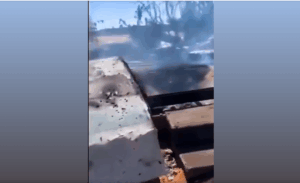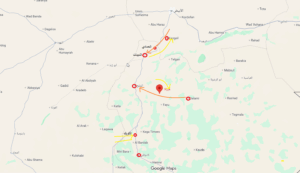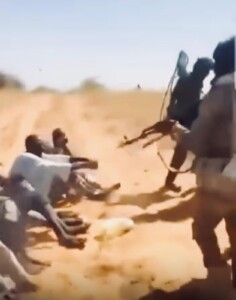MoH in Blue Nile: ‘Displaced will suffer from waterborne diseases’
The Minister of Health in the Blue Nile region Jamal Nasir, warned of an impending health catastrophe owing to the lack of adequate sanitation facilities available in the school buildings being used as shelters by the recently displaced.
 Thousands of people fled fierce fighting near El Roseires and Ed Damazin in July (social media)
Thousands of people fled fierce fighting near El Roseires and Ed Damazin in July (social media)
The Minister of Health in the Blue Nile region Jamal Nasir, warned of an impending health catastrophe owing to the lack of adequate sanitation facilities available in the school buildings being used as shelters by the recently displaced.
Earlier this week, Nasir told Radio Dabanga that the thousands of displaced people using schools as impromptu shelters, “may suffer from an outbreak of diarrhoea and other waterborne illnesses”.
The health minister maintained the region was free of dengue fever.
He called for the displaced to return to their original dwellings, adding that if they were unable to do so, an “appropriate alternative would be to use tents”. The minister appealed to local organisations to provide more tents and shelter materials.
Security situation
Following the arrival of military reinforcements from Khartoum, the health minister explained that the Blue Nile region is more secure, and the regional government is “seeking reconciliation between the various parties”.
Earlier this month, the region’s security committee stated that displaced people living in schools in Ed Damazin “refused to return to their original dwellings in the El Qassem locality of Blue Nile”.
The displaced people stated that they would not return until a military garrison was established in El Gasem, and adequate security measures were introduced.
Blue Nile violence
In Wad El Mahi, near El Roseires in the Blue Nile region, inter-communal violence renewed on October 13. "As fighting continues, at least 1,200 people have been displaced and an unconfirmed 170 people have been killed and 327 have been injured", UN Office for the Coordination of Humanitarian Affairs (OCHA) writes in its latest update.
As a result of the conflict, the wali (governor) of the Blue Nile region issued a decree prohibiting the movement of civilians using trucks within big parts Wad El Mahi locality. "This restriction to freedom of movement prevents people from seeking safety and accessing life-saving services, thereby endangering their right to life," OCHA states.
According to unconfirmed reports, two people from El Hamaj tribe were killed in a land dispute in Wad El Mahi on October 13, which led to clashes between the Hausa community and other tribes.
The inter-communal violence that erupted in mid-July between *Hausa, El Funj, Berta, El Hamaj, and other ethnic groups in the northern part of Blue Nile state, which left at least 105 people dead and caused thousands to flee to the state's capital Ed Damazin and safe parts of El Roseires, has flared up before. In September, at least 24 people were killed as the violence resurfaced. At 149 people died before October 6, according to OCHA.
*The Hausa in Sudan are part of the Hausa ethnic group, which is very influential in West Africa, politically and culturally. In the process of traveling and trading for centuries, some of them migrated east to places like Sudan – where they are still seen by many as outsiders.











 and then
and then